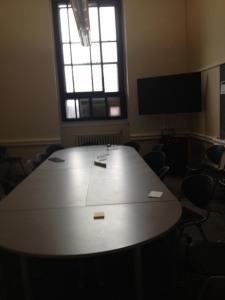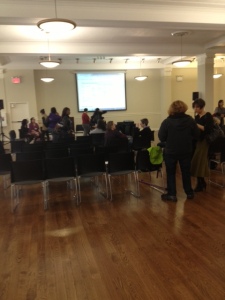The night before THATCamp, I told Michelle that I didn’t think anyone would come to our panel. Too many people had told me stories of conferences where panels about race and/or ethnicity only attracted people of color. We joked that we might be the only two people in the room.
Our panel was originally scheduled for this room:

I got there a few minutes early so I could get my head in a space to have a “productive conversation” about the kinds of “strategies” we (the few I thought would be in attendance) might have around the silences that seem to dominate the conversation about racism and feminism.
But so many people wanted to attend the panel that we ended up moving here (to the main conference room):
Michelle, who has more experience with public conversations about race than I do, said to me “this is too big” and suggested that we split the group of about 45 women (2/3 of the conference) into smaller groups. It seemed like a good idea, but I thought we could start big and then turn to smaller groups.
I had other ideas about how this could unfold. Michelle did too.
They seem less important this morning than what happens now that we’ve started this conversation, in this particular space.
After the conference, Kim Hall, Michelle, and I met over drinks to discuss, among other things, what could happen next with all of the ideas, energies, frustrations, and hopes that were in that room. I wish I had facilitated the discussion differently (asked a more focused question, started where I ended, invited other participants to begin by sharing their experiences), but I think the Session Notes offer a terrific opportunity to continue the conversation.
I think they provide a fairly accurate account of how things unfolded (it’s great to see other conference attendees still filling in the gaps), and this post is an invitation to folks to read them and share their thoughts and reactions.
In order to keep the Session Notes focused on the conference, it’s probably best to write in the comments section here. Or you might write something on your own blog and link to it in the common section here (or send the link to me via twitter @triciamatthew)
In the spirit of that invitation I’ll share that one thing I’ve been thinking about since the panel was that I talked about wanting “strategies” without clarifying who I had in mind. It really depends on your subject position though, doesn’t it? If, for example, you’re a woman of color navigating this terrain, it might be useful to know about Jay Smooth’s very popular video about how to call out racist behavior (if you’re a white person who struggles with hearing that something you’ve said or done is problematic, this could be useful for you too). It’s a good place to start. What I was hoping for was a similar resource that can be a good place to start for white feminists, something that goes beyond “Unpacking the Knapsack,” that speaks specifically to feminism and racism. I know a few attendees had ideas, so I hope they share them.
Many, many thanks to everyone who attended. I know it wasn’t an easy conversation, but I am encouraged by the number of people interested enough in this persistent (pernicious) issue to attend the panel and thankful to all whose shared their ideas, stories, and questions.

As a recently tenured woman of color who was shaken to her core by the original Clicks and Cliques post and who is still traumatized by bits of her own experience on the tt, I watched the twitter feed of the session with great interest. What I saw was nothing short of fabulous. It was great to see women of color sharing their experiences and thoughts and opinions without being shut or shouted down. It was equally refreshing to see a space where white women reflected on the issue of racism and feminism, without engaging in an exercise of universal denial. I was particularly appreciative of the session notes and the recommended readings. Indeed, I am still working my through them.
Until I find my voice on this issue, Thank you.
Thank you for writing. Given the focus of the conference, Michelle and I wanted to talk about silence and social media. We were last frustrated last spring when no one replied to either of our blog posts, but it seems that tweeting about the silence in a room full of women speaking on the issue has opened up a space for conversation
Congratulations on making it through the tenure process. It’s even harder than it looks isn’t it?
Thanks for bringing attention to these issues (yes, multiple) in your earlier blogs and continuing to address them here. I “found” this particular conversation on twitter (via @tressimcphd) and, like the previous person commenting, have been working through the notes, the earlier posts and additional recommended readings to catch up. I’ve also started to share them on my twitter feed and in other fora so the conversation can spread further – it seems that many people find these conversations to be overdue – so please, continue on! I’ll do my best to support & engage & challenge…
Sorry – forgot to say this too (maybe you can combine this with the post above when you moderate?):
I think you are absolutely right about the need for multiple strategies – not just depending on one’s subject position. But also – What is the particular issue at that specific moment? Who is the person/ institution you are trying to engage? Are you tackling the issue alone or do you have allies you can call on? What is at stake for you personally/ others around you/ the party you are engaging?
What works today, might not work tomorrow… and that is okay (think of Chela Sandoval’s discussion in “U.S. Third World Feminism: The Theory and Method of Oppositional Consciousness in the Postmodern World “- summary here: mith.umd.edu/crge/ird/pdf_entry.php?id=223), but it also means we need to have a toolbox of strategies. So yes, let’s specify the question(s), but let’s also make sure to develop & share as many strategies as possible.
Thanks for posting the Sandoval essay. It looks very interesting. I’ll be putting together a bibliography and list of resources as people share them. I’ll post on the blog at some point and will be sure to include this. I’m glad you’re here and very encouraged to know you’re sharing the conversation (I told Michelle this morning that seeing these responses made me a wee bit weepy–to have such good input after months of silence is fantastic).
“What works today, might not work tomorrow” yes! Thanks for commenting and highlighting the need to continually think, rethink, and challenge. This is not a “one and done” issue and complacency is a real danger, particularly as the work is hard and tiring! Michelle